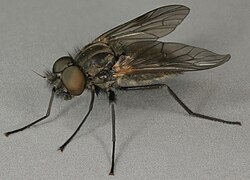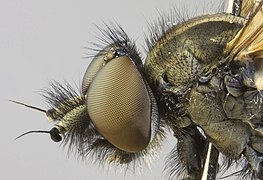Symphoromyia

| Règne | Animalia |
|---|---|
| Embranchement | Arthropoda |
| Classe | Insecta |
| Ordre | Diptera |
| Sous-ordre | Brachycera |
| Infra-ordre | Tabanomorpha |
| Famille | Rhagionidae |
| Sous-famille | Spaniinae |
Genre
Frauenfeld, 1867
Symphoromyia est un genre d'insectes diptères de la famille des Rhagionidae.
Classification
Le genre Symphoromyia a été créé en 1867 par le naturaliste autrichien Georg von Frauenfeld (1807-1873)[1].
Description
Symphoromyia est un genre de mouches bécassines prédatrices. Fait inhabituel pour les Raghionides, certaines espèces de Symphoromyia sont connues pour se nourrir de sang de mammifères, y compris de sang humain. Les espèces de Symphoromyia sont des mouches au corps robuste de 4,5 à 9 mm et avec un thorax noir, gris ou doré, et l'abdomen est de couleur grise, noire ou à la fois noire et jaune, noire se terminant par du jaune, à complètement jaune. Les ailes sont hyalines ou légèrement infusées.
Étymologie
Le nom générique, Symphoromyia, dérive du grec ancien συμφορία, symphoría, « calamité, fléau » et μυῖα, muĩa, « mouche ».
Liste d'espèces
- Symphoromyia algens Leonard, 1931[2]
- Symphoromyia atripes Bigot, 1887[3]
- Symphoromyia barbata Aldrich, 1915[4]
- Symphoromyia cervivora Turner & Chillcott, 1973[5]
- Symphoromyia cinerea Johnson, 1903[6]
- †Symphoromyia clerci Ngô-Muller & Nel, 2020[7]
- Symphoromyia crassicornis (Panzer, 1808)[8]
- Symphoromyia cruenta Coquillett, 1894[9]
- Symphoromyia currani Leonard, 1931[2]
- †Symphoromyia evecta (Meunier, 1910)[10]
- †Symphoromyia examinata (Meunier, 1910)[10]
- †Symphoromyia exigua (Meunier, 1910)[10]
- Symphoromyia fulvipes Bigot, 1887[3]
- Symphoromyia hirta Johnson, 1897[11]
- Symphoromyia immaculata (Meigen, 1804)[12]
- Symphoromyia inconspicua Turner & Chillcott, 1973[5]
- Symphoromyia incorrupta Yang, Yang & Nagatomi, 1997[13]
- Symphoromyia inquisitor Aldrich, 1915[4]
- Symphoromyia johnsoni Coquillett, 1894[9]
- Symphoromyia kincaidi Aldrich, 1915[4]
- Symphoromyia limata Coquillett, 1894[9]
- Symphoromyia liupanshana Yang, Dong & Zhang, 2016[14]
- †Symphoromyia marginata Théobald, 1937[15]
- Symphoromyia melaena (Meigen, 1820)[16]
- Symphoromyia montana Aldrich, 1915[4]
- Symphoromyia nana Turner & Chillcott, 1973[5]
- Symphoromyia nigripilosa Yang, Dong & Zhang, 2016[14]
- Symphoromyia pachyceras Williston, 1886[17]
- Symphoromyia pallipilosa Yang, Dong & Zhang, 2016[14]
- Symphoromyia pilosa Aldrich, 1915[4]
- Symphoromyia plagens Williston, 1886[17]
- Symphoromyia pleuralis Curran, 1930[18]
- Symphoromyia plumbea Aldrich, 1915[4]
- Symphoromyia pullata Coquillett, 1894[9]
- Symphoromyia sackeni Aldrich, 1915[4]
- Symphoromyia securifera Coquillett, 1904[19]
- Symphoromyia sinensis Yang & Yang, 1997[13]
- Symphoromyia spitzeri Chvála, 1983[20]
- †Symphoromyia subtrita Cockerell, 1911[21]
- †Symphoromyia succini Paramonov, 1938[22]
- †Symphoromyia tertiarica Paramonov, 1938[22]
- Symphoromyia trivittata Bigot, 1887[3]
- Symphoromyia trucis Coquillett, 1894[9]
- Symphoromyia truncata Turner, 1973[5]
- Symphoromyia varicornis (Loew, 1872)[23]
Espèces fossiles
Selon la Paleobiology Database en 2023, le nombre d'espèces fossiles est de huit :
- †Symphoromyia clerci Ngô-Muller and Nel, 2020
- †Symphoromyia eocenica Nel et al., 2016
- †Symphoromyia evecta Meunier, 1910
- †Symphoromyia examinata Meunier, 1910
- †Symphoromyia marginata Théobald, 1937
- †Symphoromyia subtrita Cockerell, 1911
- †Symphoromyia succini Paramonov, 1938
- †Symphoromyia tertiarica Paramonov, 1938
Galerie
- Quelques espèces vivantes du genre Symphoromyia.
-
 Symphoromyia crassicornis.
Symphoromyia crassicornis. -
 Symphoromyia crassicornis - détail tête et haut du thorax.
Symphoromyia crassicornis - détail tête et haut du thorax. - Symphoromyia immaculata.
Bibliographie
![]() : document utilisé comme source pour la rédaction de cet article.
: document utilisé comme source pour la rédaction de cet article.
Liens externes
Sur les autres projets Wikimedia :
- Symphoromyia, sur Wikimedia Commons
- Symphoromyia, sur Wikispecies
- Ressources relatives au vivant
 :
: - BugGuide
- Dyntaxa
- EU-nomen
- Fauna Europaea
- Paleobiology Database
- Global Biodiversity Information Facility
- iNaturalist
- Interim Register of Marine and Nonmarine Genera
- Muséum national d'histoire naturelle
- NBN Atlas
- Nederlands Soortenregister
- Système d'information taxonomique intégré
- Notices d'autorité
 :
: - Israël
- (en) Référence Catalogue of Life : Symphoromyia Frauenfeld, 1867 (consulté le )
Notes et références
Notes
Références
- ↑ (en) Référence Paleobiology Database : Symphoromyia Frauenfeld 1867 (snipe fly) (consulté le ).
- ↑ a et b M.D. Leonard, « Two new species of Symphoromyia (Rhagionidae, Diptera) from the eastern United States », American Museum Novitates, vol. 497, , p. 2 pp (lire en ligne, consulté le )
- ↑ a b et c J.M.F. Bigot, « Diptères nouveaux ou peu connus. Leptidi J. B. (Meigen, System. Beschr., II, 1820) », Bulletin de la Société Zoologique de France, vol. 12, , p. 97-118 (lire en ligne, consulté le )
- ↑ a b c d e f et g J.M. Aldrich, « The dipterous genus Symphoromyia in North America », Proceedings of the United States National Museum, vol. 49, no 2099, , p. 113-142 (lire en ligne, consulté le )
- ↑ a b c et d W. Turner et J.G. Chillcott, « Four new species of the Symphoromyia pachyceras complex complex from California (Diptera: Rhagionidae) », The Pan-Pacific Entomologist, vol. 49, , p. 5-20
- ↑ C.W. Johnson, « Some notes and descriptions of three new Leptidae », Entomological news, and proceedings of the Entomological Section of the Academy of Natural Sciences of Philadelphia, vol. 14, , p. 22-26 (lire en ligne, consulté le )
- ↑ V. Ngo-Muller et A. Nel, « A new Symphoromyia in the Middle Eocene Baltic amber (Diptera: Rhagionidae) », Zootaxa, vol. 4820, no 2, , p. 373-378
- ↑ G.W.F. Panzer, Favnae insectorvm Germanicae initia oder Devtschlands Insecten. H. 73, Nurnberg [= Nuremberg], Felsecker, , 24 pp., 24 pls
- ↑ a b c d et e D.W. Coquillett, « Synopsis of the dipterous genus Symphoromyia », Journal of the New York Entomological Society, vol. 2, , p. 53-56 (lire en ligne, consulté le )
- ↑ a b et c F. Meunier, « Monographie der Leptiden und der Phoriden des Bernsteins », Jahrb. Preuss. Geol. Landesanst. Berlin, vol. 30 (1909), , p. 64-90, 5 pls.
- ↑ C.W. Johnson, « Some notes and descriptions of new Leptidae », Entomological news, and proceedings of the Entomological Section of the Academy of Natural Sciences of Philadelphia, vol. 8, , p. 117-120 (lire en ligne, consulté le )
- ↑ J.W. Meigen, Klassifikazion und Beschreibung der europäischen zweiflügligen Insekten. (Diptera Linn.). Erster Band. Abt. I. Abt. II.., Braunschweig [= Brunswick], Reichard, , xxviii + pp. 1-152, vi + pp. 153-314
- ↑ a et b D. Yang, C.K. Yang et A. Nagatomi, « The Rhagionidae of China (Diptera) », South Pacific Study, vol. 17, no 2, , p. 113-262
- ↑ a b et c D. Yang, H. Dong et K.Y. Zhang, Diptera. Rhagionidae Athericidae, vol. 65, Fauna Sinica. Insecta, , ii + 472 pp
- ↑ N. Théobald, Les insectes fossile des terrains oligocenes de France, Nancy, G. Thomas, , 473 + [1] pp
- ↑ J.W. Meigen, Systematische Beschreibung der bekannten europäische n zweiflugeligen Insekten, Aachen, Zweiter Theil. Forstmann, , xxxvi + 363 (lire en ligne)
- ↑ a et b S.W. Williston, « Dipterological notes and descriptions », Transactions of the American Entomological Society, vol. 13, , p. 287-304 (lire en ligne, consulté le )
- ↑ Charles Howard Curran, « Report on the Diptera collected at the Station for the Study of Insects, Harriman Interstate Park, N.Y. Bulletin of the AMNH », Bulletin of the American Museum of Natural History, vol. 61, no 2,
- ↑ Daniel William Coquillett, « New North American Diptera », Proceedings of the Entomological Society of Washington, vol. 6, , p. 166–192 (lire en ligne, consulté le )
- ↑ M. Chvála, « First record of blood-sucking in palaearctic Rhagionidae (Diptera), with description of a new Symphoromyia of the crassicornis-group from Central Asia », Acta Ent. Bohem., vol. 80, , p. 423-436
- ↑ T.D.A. Cockerell, « Fossil insects from Florissant, Colorado », Bulletin of the American Museum of Natural History, vol. 30, , p. 71-82
- ↑ a et b S.J. Paramonov, « Zur Entomofauna der Bernsteins », Zbirnik Prats Zoologichnogo Muzeyu Ukrain'ska Akademya Nauk, vol. 18, , p. 53-64
- ↑ Hermann Loew, « Diptera Americae septentrionalis indigena. Centuria decima », Berliner Entomologische Zeitschrift, vol. 16, , p. 49–124 (DOI 10.1002/mmnd.18720160110, lire en ligne, consulté le )
 Portail de l’entomologie
Portail de l’entomologie














